Anisole on reaction with HI forms
Phenyl iodide and methyl iodide
Phenol and methanol
Phenyl iodide and methanol
Methyl iodide and phenol
The correct Answer is:D
To solve the question "Anisole on reaction with HI forms," we can follow these steps:
1. Identify Anisole:
Anisole is known as methoxybenzene, which has the structure of a benzene ring with a methoxy group (–OCH3) attached to it.
Hint: Remember that anisole is a derivative of benzene with a methoxy group.
2. Reaction with Hydrogen Iodide (HI):
When anisole reacts with hydrogen iodide (HI), the first step involves the protonation of the oxygen atom in the methoxy group by the hydrogen ion (H+) from HI.
Hint: Protonation of the oxygen increases the electrophilicity of the molecule.
3. Formation of Methyl Phenyl Oxonium Ion:
The protonation leads to the formation of a methyl phenyl oxonium ion, where the oxygen carries a positive charge. This ion is stabilized by resonance with the benzene ring.
Hint: Look for resonance structures that can stabilize the positive charge on the oxygen.
4. Bond Character and Cleavage:
The bond between the oxygen and the methyl group (–OCH3) is a single bond and can be easily broken, while the bond between the oxygen and the aromatic carbon has partial double bond character due to resonance, making it more difficult to break.
Hint: Recognize which bonds are more likely to break based on their character (single vs. partial double bond).
5. Nucleophilic Attack by Iodide Ion:
The iodide ion (I-) from HI can now attack the carbon atom of the methyl group (–CH3) because the bond is weaker. This results in the formation of iodomethane (CH3I).
Hint: Identify the nucleophile (I-) and where it will attack in the structure.
6. Formation of Phenol:
As a result of the bond cleavage, phenol (C6H5OH) is formed from the aromatic part of the molecule.
Hint: Remember that the aromatic ring remains intact while the methoxy group is converted.
7. Final Products:
The final products of the reaction between anisole and HI are phenol and iodomethane.
Hint: Write down the final balanced equation to visualize the products clearly.
Final Answer:
When anisole reacts with hydrogen iodide (HI), it forms phenol and iodomethane (methyl iodide).
Anisole is known as methoxybenzene, which has the structure of a benzene ring with a methoxy group (–OCH3) attached to it.
When anisole reacts with hydrogen iodide (HI), the first step involves the protonation of the oxygen atom in the methoxy group by the hydrogen ion (H+) from HI.
The protonation leads to the formation of a methyl phenyl oxonium ion, where the oxygen carries a positive charge. This ion is stabilized by resonance with the benzene ring.
The bond between the oxygen and the methyl group (–OCH3) is a single bond and can be easily broken, while the bond between the oxygen and the aromatic carbon has partial double bond character due to resonance, making it more difficult to break.
The iodide ion (I-) from HI can now attack the carbon atom of the methyl group (–CH3) because the bond is weaker. This results in the formation of iodomethane (CH3I).
As a result of the bond cleavage, phenol (C6H5OH) is formed from the aromatic part of the molecule.
The final products of the reaction between anisole and HI are phenol and iodomethane.
When anisole reacts with hydrogen iodide (HI), it forms phenol and iodomethane (methyl iodide).
Topper's Solved these Questions
- ALCOHOLS, PHENOLS & ETHERSBOOK - VMC MODULES ENGLISHCHAPTER - ALCOHOLS, PHENOLS & ETHERSEXERCISE - Impeccable
100 Videos
- ALCOHOLS, PHENOLS & ETHERSBOOK - VMC MODULES ENGLISHCHAPTER - ALCOHOLS, PHENOLS & ETHERSEXERCISE - Enable
100 Videos
- ALCOHOLS, PHENOLS & ETHERS BOOK - VMC MODULES ENGLISHCHAPTER - ALCOHOLS, PHENOLS & ETHERS EXERCISE - IN-CHAPTER EXERCISE - L
10 Videos
- ALDEHYDES,KETONES & CARBOXYLIC ACIDS BOOK - VMC MODULES ENGLISHCHAPTER - ALDEHYDES,KETONES & CARBOXYLIC ACIDS EXERCISE - IN-CHAPTER EXERCISE-M
10 Videos
Similar Questions
Knowledge Check
Benzene on reaction with A form
 which one reaction with B form
which one reaction with B form  A
A B
B C
C D
D
Phenyl methyl ether (on anisole) reacts with HI to give phenol and methyl iodide and not iodobenzene and methyl alcohol. Justify .
AI− ion prefers to combie with the smaller group in order to minimise steric hindrance group in order to minimise steric hindranceBI− ion is not ractive towards benzneCphenol is formed as a result of hydrolyis of iodobenzeneDmehtyl alcohol fromed durin reaction racts wit I− to from methyl iodile .Which of the following reactions will not result in the formation of anisole?
A B
B C
C D
D
Glucose on prolonged heating with HI, forms
View SolutionAnisole on cleavage with HI gives:
View Solution2-4 dinitroaniline is treated with NaNO2 and dilute HCI at 280 K followed by reaction with anisole , forming a coloured compound . The structure of this coloured compound would be :
View SolutionWhen glycolic acid is subjected to reduction with HI, the product formed is :
View SolutionWhen anisole is heated with HI , the product is :
View Solution
